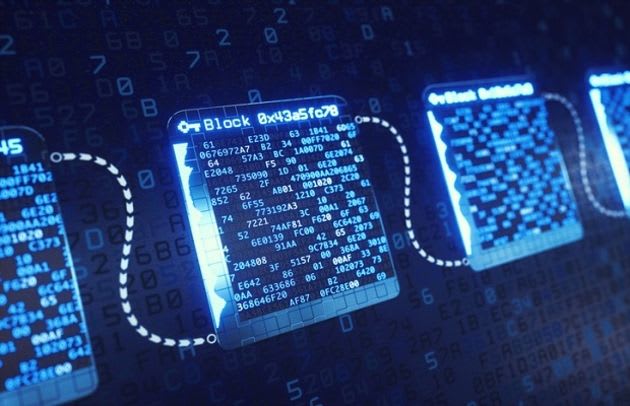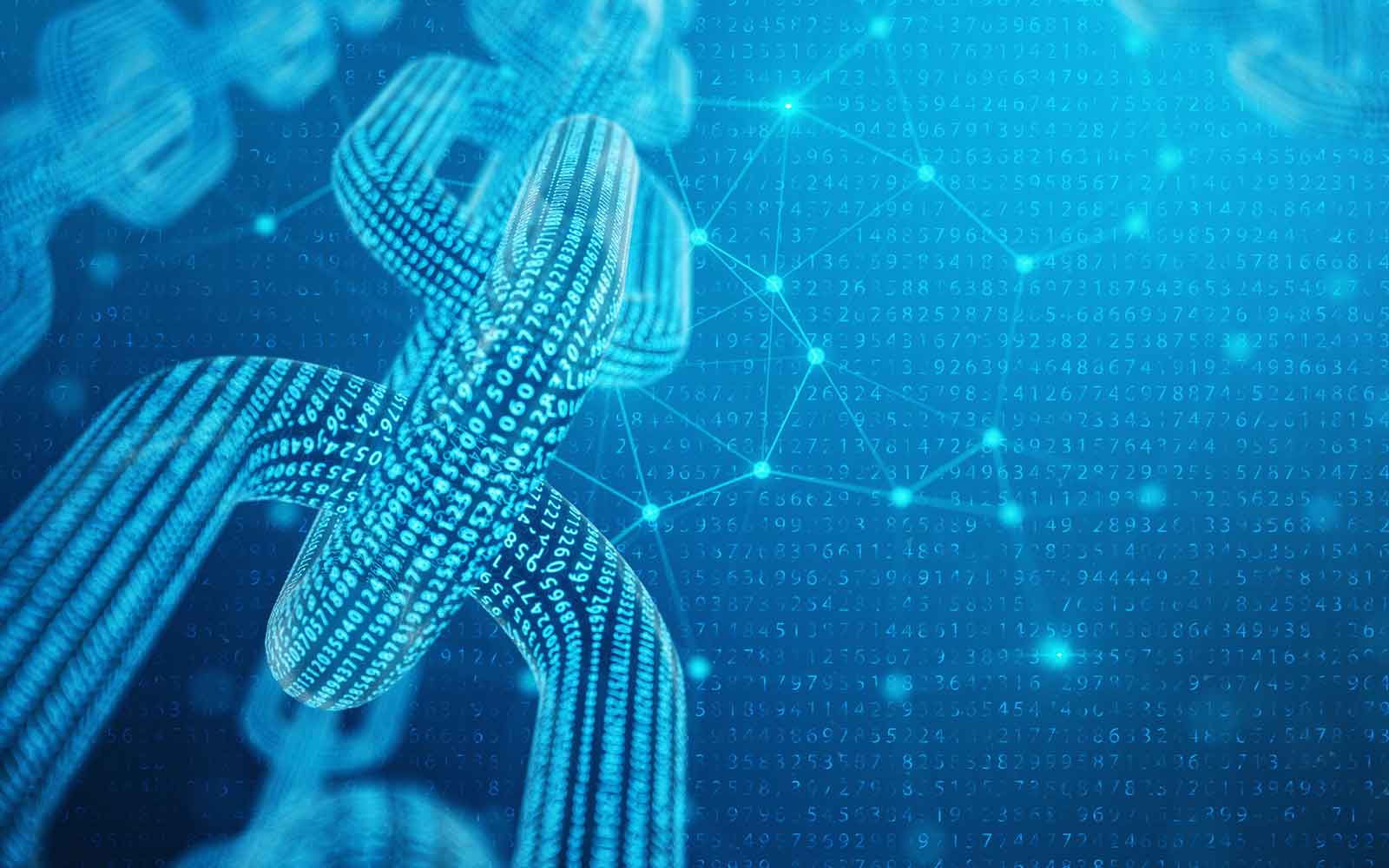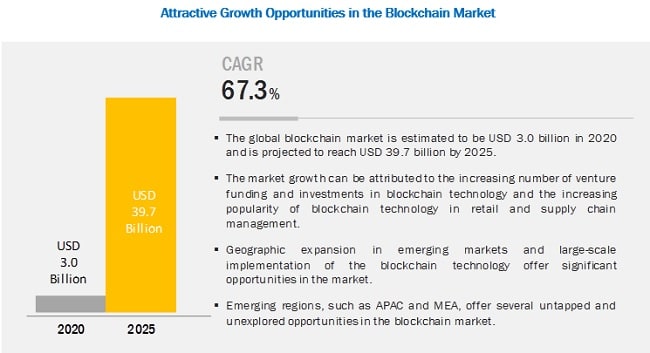What is Blockchain? A Tutorial

The idea of blockchain itself may sound complicated, but the premise is simple. Blockchain is a zero-trust, fully decentralized peer-to-peer data storage system that spreads verified information across participants in the chain, referred to as nodes. Blockchain stores this information in blocks that are chained together. As new data arrives, it is recorded into a block. Once a block has been filled with information, it is linked to the previous block. This process allows the data to be bound together in sequential and chronological order.
The blockchain can store multiple information types within a block. The most popular use for this technology has been implemented as a record for financial transactions. Blockchains are immutable, which implies that the data placed in them are unchangeable.
A good example is the popular cryptocurrency Bitcoin, which uses a decentralized version of blockchain. It is implemented in such a way so that no group or single person has control. Its users collectively maintain control. Satoshi Nakamoto invented blockchain technology to create a medium for the world’s first cryptocurrency, namely Bitcoin.
Main Traits of Blockchain
Decentralization
This means that the servers which store the blockchain data are not in a single centralized location like a datacenter or company. The information is stored on servers worldwide and is not controlled by a single entity or group. Each node or server has a complete record of all the data stored on the blockchain since its beginning. If one server shows an inaccuracy within its local data, blockchain uses the information stored in thousands of other servers as a reference to correct the error. Because the data stored on the servers is immutable or unchangeable, no single node within the network can alter its information.
Transparency
All the blocks within a blockchain can be reviewed using either a server node connected to the blockchain or a blockchain explorer. Because of Bitcoin’s decentralized nature, all transactions can be transparently inspected by either controlling an individual node or using a blockchain explorer. A blockchain explorer is an application that uses an API and a blockchain server or node to extract data from a blockchain. This software then uses a database format to arrange the returned data to the user in a readable and searchable format.
The explorer allows anyone to monitor live transactions that are occurring. Since each blockchain server has its local copy of the information, any information updated within a new block is confirmed by the other servers and added. The downside here is the limited privacy involved with participants of the blockchain.

Security
Blockchain technology considers security to be of the utmost importance. It accounts for establishing trust in multiple ways, including access control, identity management, and data integrity:
- New blocks are consistently stored linearly. This means they are always added chronologically to the “end” of the blockchain. When reviewing a blockchain, it should be noted that each block has a relevant position in the chain called a block height. A block height is defined as the number of blocks in the chain between any specified block and the blockchain's first block.
- Once a block is added to the end of the blockchain, it is almost impossible to modify the block’s data unless a majority of nodes agree to the change.
- Each block contains its own hash code and the previous and preceding block’s hash code, including a timestamp. These hash codes are produced by an algorithm that converts the digital data into a string of letters and numbers. If any information in the block is manipulated in any manner, the hash code will change.
Scalability
The growth variables involved with data storage and retrieval are dependent on multiple factors, including:
- How many participants are included in the blockchain?
- How much data will be stored?
- The infrastructure process involved when creating new nodes.
These factors and many others contribute to the overall extensibility, resilience, and stability of the technology.
Mining
The term mining is commonly associated with obtaining bitcoins. While partially true, mining is geared more towards the creation and validation of the blocks. The master node runs an infinite loop that waits for new, unconfirmed block transactions. Once validation occurs via an integrity check, validity is approved, and a new block is created.
When mining completes, the mined block is shared with other known nodes. Built-in software watchdogs ensure that network issues or remote failures do not hinder the related connection’s reinitialization. There is no reward for mining in the sense of a bitcoin being issued, but more so the node’s incentive to limit resource expenditures when operating in a trustless network without a core, centralized function.
Who Uses Blockchain?
Blockchain is currently used across multiple global verticals, including these silos:
- Healthcare/Medicine: Securing patient records, HIPAA, and privacy.
- Education: Digital transcript, documents, and payments.
- Finance/Banking/Insurance: Digital records, transactions, and ledgers.
- Manufacturing/Construction: Procurement, supply chain, and QA.
- Science: Data sharing, reference material, and R&D.
- Pharmaceuticals: Tracking trial data, prescription sharing, and supply chain.
- Agriculture/Farming: Traceability in food supply chain and data storage.
- Government/Defence/Public Sector: Secure record storage, oversight, and transparency.
- Business/Retail: Supply chain, recordkeeping, and secure contracts.
- Energy/Utility: Data management, systems interoperability, and environmental impact.
- Telecommunications/IT: Security, transparency, control, and data immutability.
- Transportation/Logistics: Supply chain, tracking payments, and improved standards.
- Media/Entertainment/Communication: Royalties, trademarking, intellectual property

Advantages of Blockchain
Blockchain relies on three fundamental tenets:
- Cryptographic strength.
- Inherent decentralization.
- A concerted, agreed-upon consensus of trust.
Other advantages include the following components.
Decentralization
Because the information stored in a blockchain is decentralized, data loss becomes a non-issue. Retrieval of information is faster because multiple nodes exist in a vast network of servers worldwide.
Security
Blockchain is advantageous in securing essential data that may require future review. Blockchain security relies on the immutable nature of the system to maintain information integrity, which reduces the risk of attack and fraud.
A blockchain system uses a one-way hash function. This mathematical algorithm uses a variable-length string of data and converts it into a binary sequence with a fixed-length. This ensures the output bears no relationship to the input information. This process is difficult to reverse because, given the outcome, the input is impossible to determine. Furthermore, the newly generated block strictly follows the linear sequence of time.
Immutability
Once data is written to the block, it becomes immutable. In programming, immutability is defined as an element whose state, once established, cannot be changed or modified after its creation. Manipulating any block data would trigger a different hash value and would be detected by the other nodes who sync in real-time and run the identical hash validation algorithm. Any attempt at tampering would require the approval of over 51% of the current network nodes which store the shared data.
Efficiency
As an example, interstate banking transactions sent through a central processing center can take several days to complete. These financiers are only open during business hours. Blockchain works 24 hours a day year-round. Banking transactions can be finalized in a few minutes and are deemed secure within hours. This is definitely advantageous for interstate and international transactions, which take longer since all entities involved must confirm the processed payments.
Cost & Time Savings
The by-product of blockchain technology significantly reduces labor costs and improves the process’s overall efficiency via automation. Reducing the time frame involved in processing settlements also include the benefits of transactions being run through pre-set procedures approved by all entities involved. This then makes the reconciliation procedure move more quickly and efficiently.
Transparency
Because many blockchain technologies are open-sourced software, anyone can review the codebase to ensure inconsistencies are quickly addressed. This framework provides auditors the capacity to inspect and examine transactions for security. This also implies that there is no central oversight on who controls the code or how it is manipulated. A trust exists between all the distributed nodes based on mathematical methodologies rather than a centralized agency. Additionally, any system participant can suggest a modification of the system. If the majority of nodes agree that the updated code version is amenable to all parties involved, it can then be updated.
Stability
Due to the diversified nature of the system, blockchain has no single point of failure. This increases the continuity and durability of the system. Also, all operations on the blockchain are structured in chronological order. The blocks are interconnected with adjacent blocks via a cryptographic hash function. This functional hash value links a previous block to the current block, including a hashed key pointing to the next block. Therefore, each transaction is trackable by examining the block information linked by the hash key links.

Disadvantages of Blockchain
Energy Consumption
Running thousands or even millions of nodes can be costly, inefficient, and increase unsustainable energy consumption. With the recent push towards green technologies, and worries surrounding climate change, data miners and large mining farms utilize a significantly disproportionate amount of energy compared to the desired outcome. In this sense, the processing of large amounts of blockchain data does not allow for a sustained or renewable energy-efficient environment. In our current landscape, the ecological impact can make this technology untenable in the long run.
Data Modification
While one of the strengths of blockchain technology is its ability to maintain data integrity, the downside to this is changing the blockchain data. If information is changed or modified, the change can be demanding and may require a hard fork. A hard fork is a process where one blockchain is abandoned, and a new blockchain is forked into a new chain. Typically, hard forks occur when a node adds new data in a manner that conflicts with the old nodes’ data. This means that new nodes can only communicate with other nodes that operate within the new blockchain version. The result is a blockchain split, which creates two separate blockchain networks, one that is using the old data and one that uses the new data.
Complexity
Implementing a new blockchain system requires a significant effort, especially in terms of business processes, technology updates, and modernized training. This can be a hindrance to many companies due to the costs and complexity involved in this pursuit. Adding to this concern, some companies opt for a hybrid implementation, which further complicates the issue.
Size Accommodations
To verify the blockchain data, each node must download the information in the entire chain. Depending on the chain’s size and structure, this can increase disk usage on the local node to a prohibitive level. Currently, the ledger size for the bitcoin chain has exceeded 326 GB by early 2021. This file contains all the records of every transaction that has occurred in the past on the network.
Steps to Implement Blockchain
Consider the questions below when designing a blockchain solution. The supplier of your blockchain version should ask questions like this and many others to tailor the custom solution to fit your specific business needs:
- What is the management plan for training the participating members?
- What information will be collected in the blocks?
- Are there any relevant regulatory concerns that need to be met?
- Will identity management, encryption, or security keys need to be managed?
- Does the plan include a disaster recovery plan for blockchain users?
- How will the company’s security posture be implemented for blockchain clients?
- Is there a methodology in place for resolving blockchain hash collisions?

Implementation Guidelines
While the following principles are not specifically sequential in nature, they should be considered recommendations to consider during the implementation process.
- Develop a Specific Business Use Case Objective: This is where we review the exact goals we are trying to accomplish using blockchain technology.
- Choose the Right Blockchain Solution: There are multiple blockchain solutions available depending on your goals and needs. They can use open-source software, closed source software, or a blending of the two.
- Public Blockchains: Ethereum or Bitcoin - Allows multiple participants and is fully transparent to the public.
- Private Blockchains: R3 Corda or Hyperledger - Transactions are private and only available to approved users. They are typically more centralized than a public blockchain.
- Consortium - Managed by a group like banks or governments, which share collaborative data.
- Hybrid Blockchains: Dragonchain - Combines aspects of both public and private blockchains.
- Develop an Interactive, Internal Community to Contribute Standards: When implementing new technology like blockchain, a full accounting of the types of stakeholders, their roles, and what they will be using the system for is required. Project owners should designate a knowledgeable individual from each department to gather data and share information with the project developers. This type of user input is imperative for those participating in the changeover to ensure their processes and standards are considered.
- Design the System Intentionally to Fit Existing Processes: Once the standards review process has been completed, an evaluation will need to be accomplished to compare the system features’ availability to existing business processes. Ensuring those needs are met is of the highest priority at this point. It is useless to enact a new blockchain system that fails to meet even a small part of the existing process goals. If a slight process alteration can be made, which does not affect the task’s overall effectiveness, the group can evaluate and make suggested changes before the changeover.
- Plan for Uncertainty: Having the foresight to anticipate issues or concerns is the next step in this process. Once the process evaluations are completed, disaster recovery plans should be designed to prevent system failures during, or right after, the system’s rollout. Disruption of business processes can be devastating if intermediate recovery methods are not implemented and strategies fail to meet expected standards. The project team should take this step during the design phase to ensure business continuity is in place.
Conclusion
This technology’s exponential growth is expected to develop rapidly over the coming years. The global blockchain market is expected to be worth $3 billion in 2020 and more than $39 billion by the year 2025.

credit to: marketsandmarkets.com
In summary, blockchain is a stable, secure, and distributed ledger system that creates a cryptographically immutable account of records. It is safeguarded by a decentralized network of nodes where all data records are linked and approved by shared consensus.
This will especially be true if the ease of implementation is upgraded to allow a simple transition into more diverse markets. This will allow more business owners to take advantage of and use this system.
Want More Information?
Have questions? Our knowledgeable Solutions and Experienced Hosting advisors will explain how you can take advantage of this platform using either our Managed Cloud or Private Cloud Powered by VMware and NetApp!
If you are on a Fully Managed VPS server, Cloud Dedicated, Private Parent server, or a Dedicated server owner and want to make a change, give us a call at 800.580.4985, or open a chat or ticket with us to find out how!
Related Articles:

About the Author: David Singer
I am a g33k, Linux blogger, developer, student, and former Tech Writer for Liquidweb.com. My passion for all things tech drives my hunt for all the coolz. I often need a vacation after I get back from vacation....
Our Sales and Support teams are available 24 hours by phone or e-mail to assist.
Latest Articles
How to use kill commands in Linux
Read ArticleChange cPanel password from WebHost Manager (WHM)
Read ArticleChange cPanel password from WebHost Manager (WHM)
Read ArticleChange cPanel password from WebHost Manager (WHM)
Read ArticleChange the root password in WebHost Manager (WHM)
Read Article


